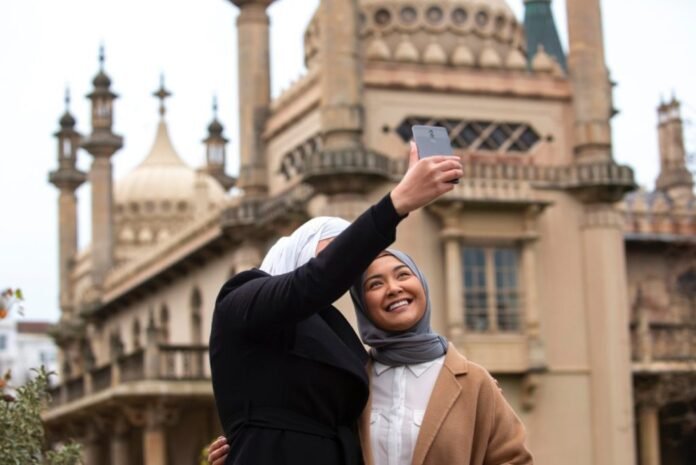The global Muslim travel market is expected to reach $235 billion by 2030, up from $189 billion in 2024, according to the 2025 Mastercard-CrescentRating Global Muslim Travel Index (GMTI), released last month.
The Muslim, or halal, travel sector caters to the specific needs of Muslim travelers, including halal-certified food, access to prayer spaces, and accommodations that align with Islamic values. The Muslim travel index, a widely cited benchmark, tracks this segment and ranks 145 destinations worldwide using a four-point framework: Access, Communication, Environment, and Services.
The report attributes the sector’s projected growth to three key trends: a rising global Muslim population, from 2.12 billion in 2024 to a projected 2.47 billion by 2034, increasing disposable income, and better access to travel infrastructure. In 2024, international arrivals of Muslim travelers were 10% higher than pre-pandemic levels.
Malaysia and Singapore On Top
Southeast Asia continues to outperform other regions in attracting Muslim travelers. Malaysia once again ranked first among Muslim-majority destinations. Singapore leads all non-Muslim-majority countries, thanks to its extensive halal food offerings, inclusive tourism services, and traveler-friendly airport infrastructure.
“Thailand has been targeting the halal travel market for a long time, primarily to attract tourists from Malaysia and Indonesia,” said Fazal Bahardeen, CEO of CrescentRating.
He noted that the Philippines is becoming a serious contender, “They’re (The Philippines) the first non-Muslim destination to offer a halal-friendly beach in Boracay for Muslim families.” The Philippines Department of Tourism created a halal travel portfolio, expanded halal food certifications, and launched awareness training for tourism operators.
Speaking at the Skift Asia Forum, Christina Garcia Frasco, tourism secretary of the Philippines, discussed how there has been a very serious push towards expanding the Philippines’ Muslim-friendly tourism portfolio.
Other Asian destinations including Taiwan, Hong Kong, Japan, South Korea, Vietnam, and Cambodia are also investing in halal-friendly offerings. Hong Kong and Taiwan ranked third and fourth, respectively, among non-Muslim-majority destinations in the travel index.
What Muslim Travelers Actually Want
“Many people have a misconception that halal travel is limited to the Middle East,” said Azwan Ariffin of Tripfez, a Malaysia-based online travel agency focused on Muslim-friendly travel. “In reality, any destination can attract halal travelers by offering food and facilities which meet their religious requirements.”
Bahardeen said that Muslim travelers want many of the same things other travelers do, such as seamless digital services, cashless transactions, and streamlined immigration, but with an added layer of faith-based considerations.
“The Muslim market is not a behemoth,” he said. “It’s segmented into three categories, depending on how strictly Muslim travelers observe their faith: 20% are ‘strictly practicing,’ 60% are ‘practicing,’ and 20% are ‘less practicing.’”
Destinations must understand that each of these groups has different expectations. “Strictly practicing Muslims may require dedicated prayer facilities and halal-only dining and accommodation options,” Bahardeen said. “Less practicing Muslims may need halal food available but can be more flexible on other options.”
Muslim-majority countries are often well positioned to cater to all levels of practice. Others may be limited by cultural norms, infrastructure, or funding.
“For Muslims, there are some overall essential requirements for a destination, or ‘need to have,’” Bahardeen said. “For example, halal food, access to prayer spaces, water-friendly toilets, and no Islamophobia. Then there are qualities that are ‘good to have,’ such as fasting-friendly hotels and Muslim-friendly experiences.” The final tier, described as “nice to have,” includes destinations with no non-halal food or alcohol and separate activities for men and women.
Accessibility Still Overlooked
Many Muslim travelers travel with extended family, including elderly or disabled relatives. According to United Nations Tourism, nearly 50% of people over age 60 have a disability, yet most global destinations are still not designed with their needs in mind.
Muslim travelers in particular need hotels, prayer areas, and transportation options that accommodate wheelchairs and limited mobility.
“Accessibility is a neglected area that we are trying to push,” Bahardeen said. The travel index added accessibility as a standalone category in 2023, highlighting a major gap in tourism readiness.
Gen Z and Millennials Reshaping the Market
Younger Muslim travelers are driving much of the sector’s growth. Millennials and Gen Z Muslims tend to be more mobile-first, experience-oriented, and digitally fluent.
“Younger Muslim travelers are more flexible, less strict than older generations,” said Ariffin. “For example, requiring that a hotel be clean, but not necessarily halal.”
They are also a powerful marketing force. “Younger Muslims are willing to be more adventurous and independent and can have a big positive impact on travel markets through their social media,” he said.
These travelers also help destinations smooth out seasonal peaks. Many plan trips around Islamic holidays, such as Ramadan and Eid, which fall at different times each year and can boost tourism during otherwise slower periods. “Leveraging the Muslim travel market also gives a destination more economic stability in case other tourist sectors fall off,” Bahardeen said.






